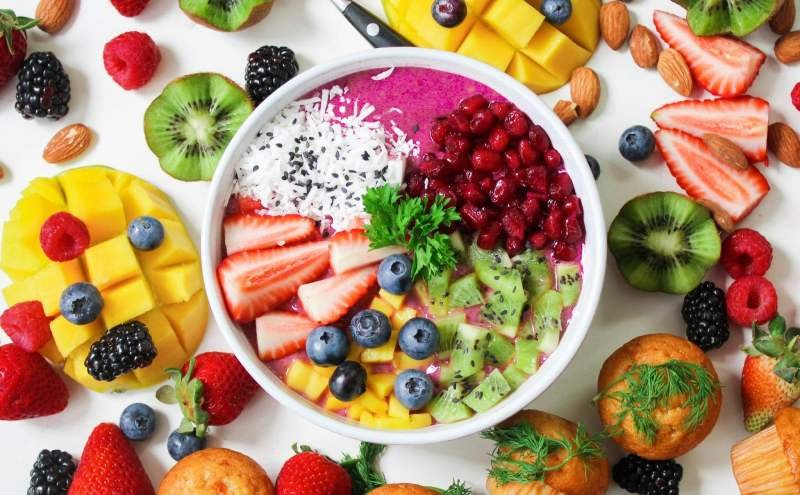Last Updated on September 26, 2025 by Local Trainer
Looking to kickstart your journey to better health? Look no further than our Ultimate 31-Day Full Meal Plan, designed to help you achieve your health goals while indulging in delicious flavors every step of the way.
Whether you’re trying to lose weight, build muscle, or simply adopt a healthier lifestyle, this comprehensive meal plan has got you covered. With carefully crafted recipes and portion control, you’ll be able to nourish your body with the right nutrients, without sacrificing taste or satisfaction.
From breakfast to dinner, and even snacks in between, our meal plan offers a variety of tasty options to suit your preferences and dietary needs. Say goodbye to the hassle of meal planning and hello to a month’s worth of culinary inspiration.
With simple and easy-to-follow instructions, you’ll be able to effortlessly prepare nutrient-packed meals while enjoying the benefits of a well-balanced diet. Get ready to embark on a delicious journey that will leave you feeling nourished, energized, and on the path to achieving your health goals.
Meal planning basics – understanding macronutrients and portion control
Following a full meal plan offers numerous benefits for your overall health and well-being. By incorporating a variety of nutritious foods into your diet, you can experience increased energy levels, improved digestion, enhanced mental clarity, and even weight loss.
One of the main advantages of a full meal plan is that it takes the guesswork out of what to eat. With a carefully curated selection of recipes, you’ll have a clear roadmap for your daily meals, ensuring that you stay on track with your health goals. Additionally, a full meal plan provides structure and routine, making it easier to establish healthy eating habits that are sustainable in the long term.
By following a full meal plan, you’ll also be able to better manage portion control. Each recipe is designed to provide the right balance of macronutrients, ensuring that you consume the appropriate amount of protein, carbohydrates, and healthy fats. This can help prevent overeating, promote satiety, and support weight management.
Finally, a full meal plan can introduce you to a wide range of nutritious and delicious foods that you may not have tried before. With a variety of recipes to choose from, you’ll be able to expand your culinary horizons and discover new flavors and textures. This can make healthy eating more enjoyable and sustainable in the long run.
Grocery shopping for the full meal plan
Before diving into the 31-day full meal plan, it’s important to understand the basics of meal planning, including macronutrients and portion control.
Macronutrients, also known as macros, are the three main nutrients that our bodies need in large quantities: protein, carbohydrates, and fats. Each macronutrient plays a crucial role in our overall health and provides energy in different forms.
Protein is essential for muscle growth and repair, as well as supporting a healthy immune system. Good sources of protein include lean meats, poultry, fish, eggs, legumes, and tofu.
Carbohydrates are the body’s primary source of energy. They are found in foods such as whole grains, fruits, vegetables, and legumes. It’s important to choose complex carbohydrates that are high in fiber and provide sustained energy throughout the day.
Fats are important for hormone production, brain function, and the absorption of fat-soluble vitamins. Healthy fats can be found in foods such as avocados, nuts, seeds, olive oil, and fatty fish.
In addition to understanding macronutrients, portion control is key when it comes to maintaining a balanced diet. It’s important to be mindful of the quantity of food you consume, as even healthy foods can contribute to weight gain if consumed in excess. Using measuring cups, food scales, and visual cues can help you determine appropriate portion sizes.
Meal prep tips and tricks
To successfully follow the 31-day full meal plan, it’s essential to start with a well-planned grocery shopping trip. By having all the necessary ingredients on hand, you’ll be able to effortlessly prepare your meals throughout the month.
Before heading to the store, take some time to review the meal plan and make a list of all the items you’ll need. Organize your list by sections, such as fruits and vegetables, proteins, grains, and pantry staples. This will make your shopping trip more efficient and ensure that you don’t forget any important ingredients.
When selecting produce, opt for a variety of colorful fruits and vegetables to ensure you’re getting a wide range of nutrients. Choose lean proteins such as chicken, turkey, fish, and tofu. For grains, opt for whole grain options like quinoa, brown rice, and whole wheat bread. Lastly, stock up on pantry staples like herbs, spices, olive oil, and vinegar to add flavor to your meals.
It’s also a good idea to check your pantry and fridge before you go shopping to see if you already have any of the ingredients on your list. This will help you avoid purchasing duplicates and save money.
Week 1 of the 31-day full meal plan – breakfast, lunch, and dinner recipes
Meal prepping is a key component of successfully following the 31-day full meal plan. By spending a few hours each week preparing your meals in advance, you can save time and ensure that you have healthy options readily available throughout the day.
Start by setting aside a specific day and time each week for meal prep. This will help you establish a routine and make it easier to stick to your plan. Choose a day when you have a few hours to spare, such as a Sunday afternoon.
Begin by washing and chopping your fruits and vegetables. This will make it easier to grab them for snacks or incorporate them into your meals. You can store them in airtight containers or reusable bags for easy access.
Next, cook your proteins and grains in bulk. This can include grilling chicken breasts, baking salmon, or preparing a large batch of quinoa or brown rice. Divide them into portion-sized containers or ziplock bags and store them in the refrigerator or freezer.
You can also prep your meals for the week by assembling ingredients in containers. For example, you can prepare mason jar salads by layering vegetables, protein, and dressing. This way, you can simply grab a jar in the morning and have a nutritious lunch ready to go.
Lastly, don’t forget about snacks! Prepare snack-sized portions of nuts, seeds, or pre-cut fruits and veggies to have on hand when hunger strikes between meals.
By dedicating a few hours each week to meal prep, you’ll save time and make it easier to stick to your 31-day full meal plan.
Week 2 of the 31-day full meal plan – breakfast, lunch, and dinner recipes
Week 1 of the 31-day full meal plan kicks off with a variety of delicious and nutritious recipes to start your journey on the right foot. Each recipe is designed to provide a balanced combination of macronutrients and flavors, ensuring that you stay satisfied throughout the day.
Breakfast:
1. Spinach and Mushroom Omelette: Start your day with a protein-packed omelette filled with sautéed spinach and mushrooms. Serve with a side of whole wheat toast for added fiber.
2. Overnight Chia Pudding: Prepare this delicious chia pudding the night before by combining chia seeds with your choice of milk, sweetener, and toppings such as berries or nuts.
3. Greek Yogurt Parfait: Layer Greek yogurt with fresh berries and a sprinkle of granola for a protein-rich and satisfying breakfast.
Lunch:
1. Quinoa Salad with Roasted Vegetables: Toss cooked quinoa with roasted vegetables like bell peppers, zucchini, and cherry tomatoes. Drizzle with a lemon vinaigrette for added flavor.
2. Chicken and Avocado Wrap: Fill a whole wheat wrap with grilled chicken, sliced avocado, lettuce, and your favorite condiments for a quick and easy lunch option.
3. Lentil Soup: Warm up with a bowl of hearty lentil soup packed with vegetables and spices. Serve with a side of whole grain bread for a complete meal.
Dinner:
1. Baked Salmon with Roasted Asparagus: Season salmon fillets with lemon juice, garlic, and herbs, then bake until tender. Serve with roasted asparagus for a nutritious and satisfying dinner.
2. Turkey Meatballs with Zucchini Noodles: Swap out traditional pasta for zucchini noodles and top with homemade turkey meatballs and marinara sauce.
3. Stir-Fried Tofu with Vegetables: Sauté tofu with a medley of colorful vegetables and a flavorful sauce for a vegetarian-friendly dinner option.
Week 3 of the 31-day full meal plan – breakfast, lunch, and dinner recipes
In week 2 of the 31-day full meal plan, you’ll continue to enjoy a wide variety of delicious and nutrient-packed meals. These recipes are designed to keep you motivated and excited about your health journey.
Breakfast:
1. Berry Smoothie Bowl: Blend frozen berries with your choice of milk and toppings like granola and shredded coconut for a refreshing and satisfying breakfast.
2. Veggie Omelette Muffins: Whip up a batch of omelette muffins loaded with assorted vegetables for a grab-and-go breakfast option.
3. Whole Wheat Pancakes: Indulge in a stack of fluffy whole wheat pancakes topped with fresh fruit and a drizzle of pure maple syrup.
Lunch:
1. Greek Salad with Grilled Chicken: Toss together crisp lettuce, cucumbers, tomatoes, olives, feta cheese, and grilled chicken for a Mediterranean-inspired salad.
2. Quinoa Stuffed Bell Peppers: Fill bell peppers with a mixture of cooked quinoa, black beans, corn, and spices. Bake until tender and serve with a dollop of Greek yogurt.
3. Chickpea Salad Wrap: Mash chickpeas with avocado, lemon juice, and spices to create a creamy filling for a nutritious and satisfying wrap.
Dinner:
1. Grilled Shrimp Skewers with Quinoa Pilaf: Marinate shrimp in a flavorful blend of herbs and spices, then grill to perfection. Serve with quinoa pilaf for a complete meal.
2. Beef Stir-Fry with Brown Rice: Sauté thinly sliced beef with an assortment of colorful vegetables and a savory sauce. Serve over a bed of brown rice for a satisfying dinner.
3. Eggplant Parmesan: Breaded and baked eggplant slices layered with marinara sauce and mozzarella cheese make for a delicious and comforting vegetarian dinner.
Week 4 of the 31-day full meal plan – breakfast, lunch, and dinner recipes
Breakfast:
1. Vegetable Frittata: Whip up a hearty vegetable frittata packed with your favorite vegetables and herbs. Serve with a side of whole grain toast for a complete breakfast.
2. Green Smoothie: Blend together a handful of leafy greens, a ripe banana, and your choice of milk for a nutritious and refreshing breakfast on the go.
3. Whole Grain Cereal with Berries: Start your day with a bowl of whole grain cereal topped with fresh berries and a drizzle of honey or maple syrup.
Lunch:
1. Caprese Salad: Arrange slices of ripe tomatoes, fresh mozzarella, and basil leaves on a plate. Drizzle with balsamic glaze for a simple yet flavorful salad.
2. Quinoa and Black Bean Burrito Bowl: Combine cooked quinoa, black beans, roasted corn, diced tomatoes, and avocado for a hearty and satisfying burrito bowl.
3. Mediterranean Hummus Wrap: Spread hummus on a whole wheat wrap and top with sliced cucumbers, tomatoes, olives, and feta cheese for a quick and delicious lunch option.
Dinner:
1. Lemon Herb Chicken with Roasted Vegetables: Marinate chicken breasts in a mixture of lemon juice, herbs, and olive oil, then bake until tender. Serve with a side of roasted vegetables for a complete meal.
2. Spaghetti Squash with Marinara Sauce: Roast spaghetti squash and top with homemade marinara sauce for a healthy and flavorful alternative to traditional pasta.
3. Grilled Portobello Mushrooms with Quinoa Salad: Marinate portobello mushrooms in a tangy dressing, then grill until tender. Serve with a refreshing quinoa salad for a satisfying vegetarian dinner.
As you near the end of the 31-day full meal plan, week 4 introduces a final set of delicious recipes to keep you motivated and on track.
Breakfast:
1. Avocado Toast: Spread mashed avocado on whole grain toast and top with sliced tomatoes, a sprinkle of sea salt, and a drizzle of olive oil.
2. Vegetable Omelette Wrap: Fill a whole wheat wrap with a fluffy omelette loaded with assorted vegetables for a satisfying and portable breakfast.
3. Overnight Oats: Combine rolled oats with your choice of milk, nuts, seeds, and sweetener. Let it sit in the fridge overnight for a convenient and nutritious breakfast.
Lunch:
1. Spinach Salad with Grilled Salmon: Toss fresh spinach leaves with cherry tomatoes, red onions, and grilled salmon. Drizzle with a lemon vinaigrette for a light and satisfying lunch.
2. Quinoa and Chickpea Buddha Bowl: Assemble a colorful bowl with cooked quinoa, roasted chickpeas, roasted vegetables, and a creamy tahini dressing.
3. Turkey and Avocado Lettuce Wraps: Wrap lean turkey slices, sliced avocado, and your favorite vegetables in crisp lettuce leaves for a low-carb and flavorful lunch.
Dinner:
1. Baked Cod with Quinoa Pilaf: Season cod fillets with herbs and spices, then bake until flaky. Serve with a side of quinoa pilaf and steamed vegetables for a nutritious dinner.
2. Vegetable Stir-Fry with Tofu: Sauté a medley of colorful vegetables with tofu and a flavorful stir-fry sauce. Serve over brown rice or quinoa for a complete meal.
3. Lentil and Vegetable Curry: Simmer lentils, vegetables, and aromatic spices to create a flavorful and hearty curry. Serve with whole grain naan bread or brown rice.
Local Trainer






